| کد مقاله | کد نشریه | سال انتشار | مقاله انگلیسی | نسخه تمام متن |
|---|---|---|---|---|
| 87960 | 159273 | 2011 | 5 صفحه PDF | دانلود رایگان |

Plant succession and mycorrhizal fungi both play crucial roles in shaping the development of forest ecosystems. However, despite the strong potential for interactions between them, few studies have examined how patterns of forest succession affect mycorrhizal associations that a majority of plant species depend on to alleviate soil resource constraints. Fire suppression in subalpine forests over the last century has changed successional patterns in ways that may have important implications for mycorrhizal associations of forest tree species. To better understand these relationships we conducted a field and greenhouse study in which we examined mycorrhizal infection along gradients of light intensity and soil nutrient availability that develop as aspen becomes seral to conifers under longer fire return intervals. We examined whether ectomycorrhizal associations of quaking aspen (Populus tremuloides), a shade intolerant, early succession species, were more sensitive to light and soil resource limitations than subalpine fir (Abies lasiocarpa), a shade tolerant, late succession species. In the field study, ectomycorrhizal infection of aspen roots was reduced by 50% in conifer dominated stands relative to aspen stands. In contrast, subalpine fir maintained its EM associations regardless of the successional status of the stand. The greenhouse results were consistent with field results and indicated that light limitation was the driving force behind reductions in EM infection of aspen roots in later stages of succession. These results suggest that nutrient limitations constraining early successional species may be exacerbated by losses in EM associations via light limitations created by late successional species. This is one potential mechanism by which climax forest species create a competitive advantage over early successional species and these results suggest that it is likely exacerbated by longer fire return intervals.
► Ectomycorrhiza in aspen are lost during late successional conifer expansion.
► Subalpine fir retain their ectomycorrhiza with successional change.
► The differential EM response between species is influenced by shade tolerance.
Journal: Forest Ecology and Management - Volume 262, Issue 2, 15 July 2011, Pages 203–207